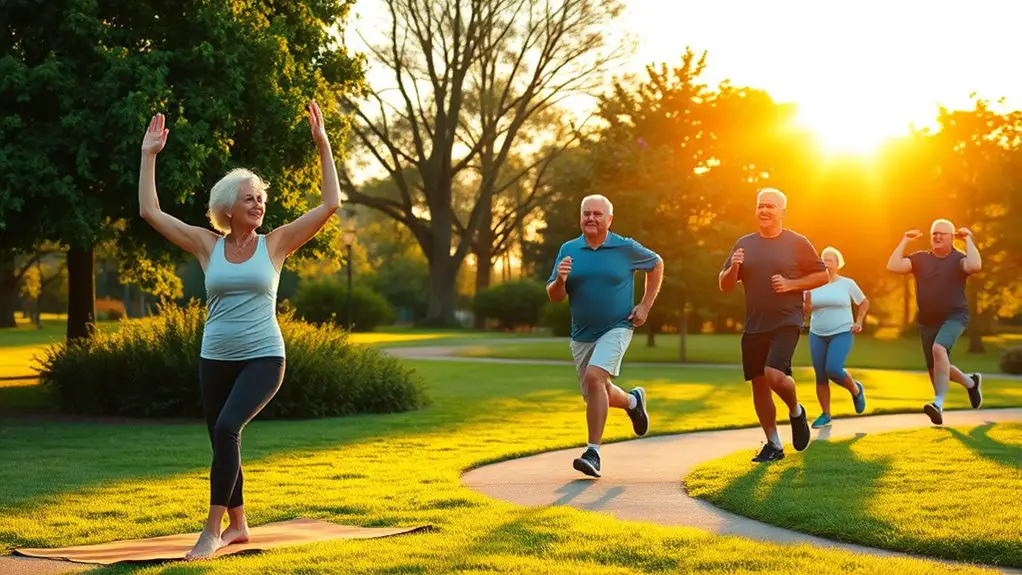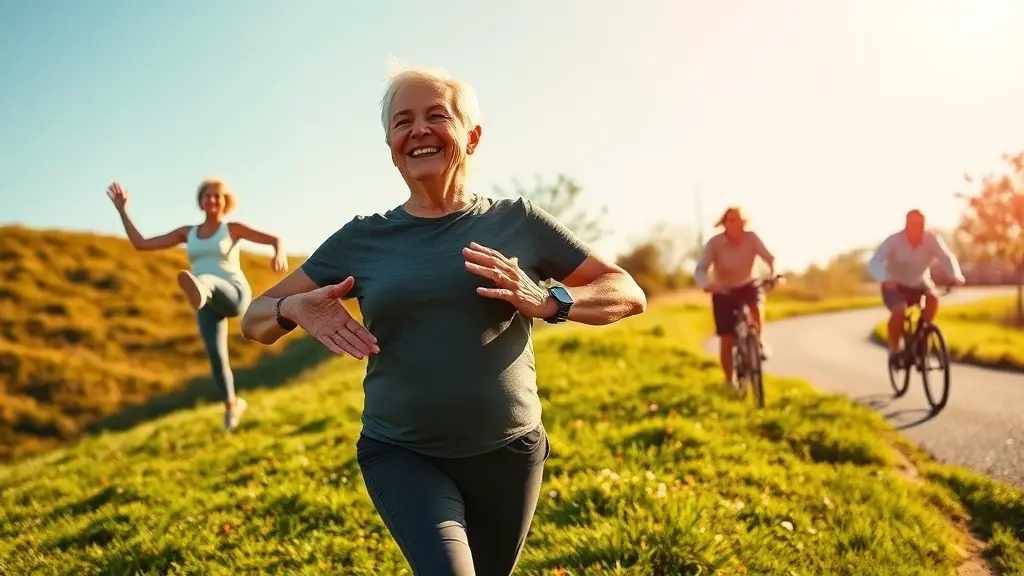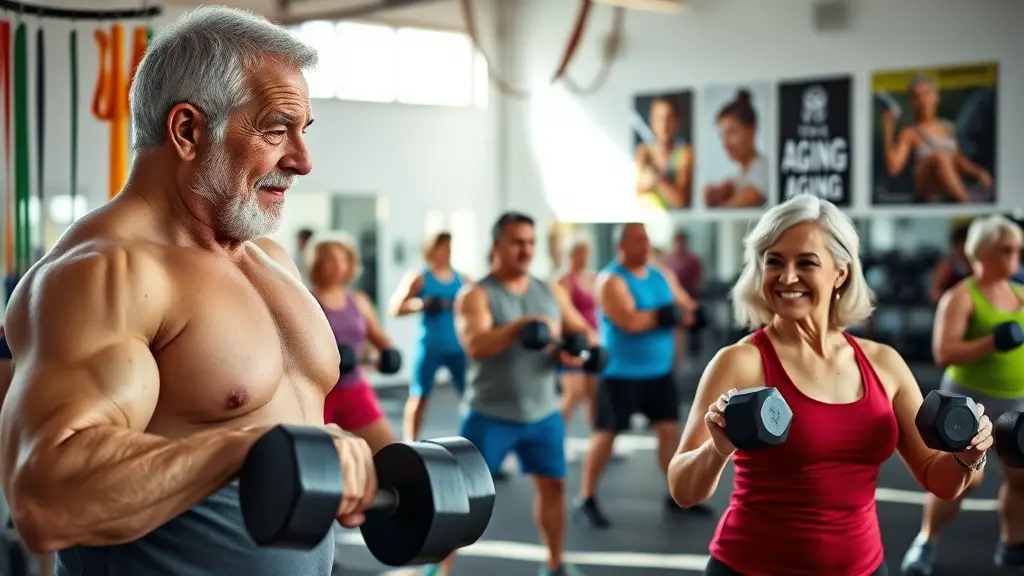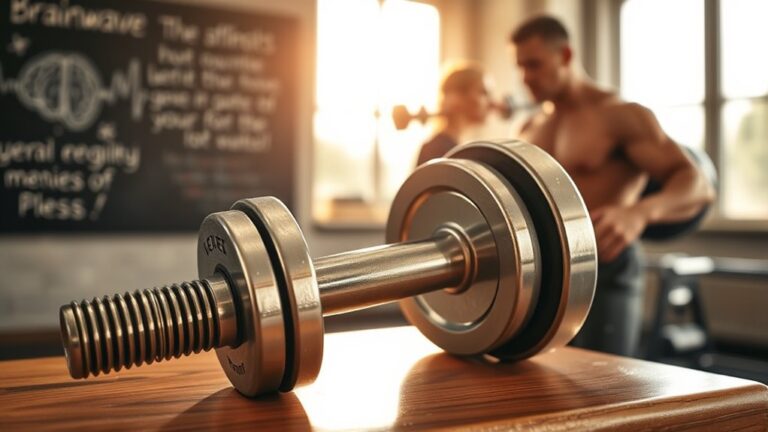How to Stay Fit and Strong Well Into Your 60S and 70S

To stay fit and strong in your 60s and 70s, focus on regular physical activity like walking, swimming, or yoga. Choose low-impact exercises to protect your joints, and incorporate strength training with bodyweight exercises or resistance bands. Don’t forget to work on flexibility and balance to enhance mobility and reduce injury risk. Eating balanced meals and staying hydrated are vital for your energy levels. By adopting these habits, you can improve your well-being and enjoy life to the fullest, plus there’s more to explore!
Understanding the Importance of Physical Activity

As you age, it is important to recognize that staying physically active can greatly enhance your quality of life. Engaging in regular exercise boosts your cardiovascular health, helping to maintain a healthy heart and reduce the risk of chronic diseases. This doesn’t just keep your body fit; it also supports your mental well-being. Physical activity releases endorphins, which can elevate your mood and combat feelings of anxiety or depression.
In your 60s and 70s, finding activities you enjoy is key. Whether it’s walking, swimming, or dancing, these exercises can make staying active feel less like a chore and more like a joy. Plus, they can improve your strength and flexibility, making everyday tasks easier. Embracing an active lifestyle can lead to better sleep, higher energy levels, and a more positive outlook on life. Additionally, incorporating exercises like skipping can improve cardiovascular fitness and provide a fun way to stay active. Remember, it’s never too late to start prioritizing your health and happiness!
Choosing the Right Exercises for Your Age
Choosing the right exercises in your 60s and 70s can greatly impact your overall health and well-being. It’s important to focus on low impact workouts that suit your body’s needs. Here are three age-appropriate activities to reflect on:
Selecting suitable exercises in your 60s and 70s is vital for health; prioritize low-impact activities that meet your body’s requirements.
- Walking: A simple, effective way to enhance cardiovascular health while being gentle on your joints.
- Swimming or Water Aerobics: These activities provide resistance training without the strain, improving flexibility and strength.
- Yoga or Tai Chi: Both promote balance, flexibility, and mental well-being, making them excellent choices for maintaining mobility.
Incorporating Strength Training Into Your Routine

Strength training plays an essential role in maintaining muscle mass and bone density as you age, so it’s crucial to integrate it into your fitness routine. Start with bodyweight exercises like squats, lunges, and push-ups; these are effective and can be done anywhere. They help build strength without the need for heavy equipment.
Incorporating resistance bands into your workouts can also enhance your strength training. They’re portable and versatile, allowing you to target various muscle groups safely. You can perform exercises like bicep curls, tricep extensions, and lateral raises with bands to keep your routine fresh and engaging.
Aim for at least two strength training sessions per week, focusing on major muscle groups. Gradually increase the intensity as you become comfortable. Remember, consistency is key. By making strength training a regular part of your routine, you’ll not only feel stronger but also support your overall health as you age. Engaging in activities like jumping rope can improve coordination and balance, complementing your strength training efforts.
Enhancing Flexibility and Balance
As you age, enhancing your flexibility and balance becomes essential for maintaining mobility and preventing injuries. Incorporating regular stretching into your routine can improve your range of motion, while balance exercises help you stay steady on your feet. Let’s explore some effective techniques to keep you agile and confident in your movements.
Importance of Stretching
Flexibility and balance are essential components of overall fitness, especially as we age. Incorporating stretching into your routine can enhance both, making daily activities easier and reducing injury risk. Here’s how you can benefit from stretching:
- Dynamic Stretching: This involves active movements that improve range of motion. Incorporate dynamic stretches before workouts to warm up your muscles.
- Static Stretching: Holding stretches for a period helps lengthen muscles and improve flexibility. Aim for static stretching after workouts to cool down and prevent stiffness.
- Increased Balance: Regular stretching can enhance your body awareness, leading to better control and stability.
Balance Training Techniques
Incorporating balance training into your fitness routine is essential for maintaining stability and preventing falls, especially in your 60s and 70s. Balance exercises can help improve your core strength, coordination, and overall stability. Start with simple activities like standing on one leg or practicing heel-to-toe walking. As you gain confidence, try adding stability training tools, such as balance boards or stability balls. Yoga and tai chi are also excellent options that enhance flexibility while focusing on balance. Aim for at least two sessions a week, and remember to listen to your body. With consistent practice, you’ll notice improvements in your balance, making daily activities safer and more enjoyable. Stay active and keep moving forward!
Nutrition Tips for Maintaining Health

How can you guarantee that your nutrition supports a healthy lifestyle in your 60s and 70s? It’s all about making smart choices that fuel your body. Here are three essential tips to keep in mind:
- Focus on Nutrient Timing: Eat balanced meals and snacks throughout the day to maintain energy levels. Aim for a mix of proteins, healthy fats, and complex carbs at each meal.
- Opt for Healthy Snacks: Choose snacks that are rich in nutrients, like nuts, yogurt, or fresh fruits. They’ll help you stay satisfied between meals and provide essential vitamins and minerals.
- Stay Hydrated: Drink plenty of water throughout the day. Proper hydration supports digestion, energy levels, and overall health.
Staying Motivated and Setting Realistic Goals
As you navigate your 60s and 70s, staying motivated to maintain your fitness can be challenging, especially if you’re unsure where to start. One effective approach is goal setting. Begin by identifying specific, achievable goals that resonate with you—whether it’s walking a certain distance or attending a weekly fitness class.
Next, implement motivation strategies that keep you engaged. Consider finding a workout buddy or joining a local group to create a supportive environment. Mix up your routine to keep things fresh and exciting.
Don’t forget to celebrate small victories along the way; this reinforces your progress and boosts your motivation. Remember, it’s about consistency, not perfection. Setting realistic goals tailored to your lifestyle will help you remain focused and energized, making it easier to stay fit and strong as you age gracefully. Additionally, fostering a community atmosphere can enhance your motivation and support as you pursue your fitness journey.
Frequently Asked Questions
What Are Common Injuries to Avoid During Exercise in Older Age?
When you’re exercising, it’s essential to be aware of common injuries you might face, especially as you age. Pay attention to joint stability; weak joints can lead to sprains or strains. To prevent injuries, focus on low-impact activities that strengthen your muscles and improve flexibility. Always warm up properly and listen to your body. If something doesn’t feel right, don’t push it—rest and consult a professional to guarantee you’re exercising safely.
How Much Sleep Do Seniors Need for Optimal Recovery?
When it comes to sleep, you’ve got to hit the hay for about 7 to 9 hours each night. As you age, your sleep patterns can change, affecting your overall recovery. By incorporating relaxation techniques like gentle stretching or meditation into your routine, you can improve your sleep quality. Prioritizing rest is essential for ideal recovery; it’s the foundation that keeps you feeling strong and energized during the day.
Can Mental Health Affect Physical Fitness in Older Adults?
Absolutely, mental health can greatly affect physical fitness in older adults. When you maintain emotional well-being, it boosts your mental resilience, making it easier to stick with exercise routines and healthy habits. Conversely, stress or anxiety can lead to fatigue and decreased motivation, hindering your physical activity. Prioritizing mental health through mindfulness, social connections, and hobbies can create a positive feedback loop, enhancing both your physical fitness and overall quality of life.
What Role Does Hydration Play in Staying Fit Over 60?
Imagine you’re hiking with friends, and you notice one of them struggling. It turns out they haven’t been drinking enough water. Hydration plays an essential role in your fitness, especially as you age. Proper water intake boosts energy levels, aids digestion, and helps maintain joint health. Staying well-hydrated can improve your performance in workouts and daily activities, so make it a habit to drink enough water throughout the day for ideal hydration benefits.
Are There Specific Exercises to Improve Bone Density?
If you’re looking to improve bone density, strength training and weight-bearing exercises are essential. These activities help stimulate bone growth by putting stress on your bones, prompting them to become stronger. Consider incorporating exercises like squats, lunges, and push-ups into your routine. Activities such as walking, jogging, or dancing also provide great benefits. Remember, consistency is vital; aim for at least 150 minutes of moderate exercise each week for best results.





